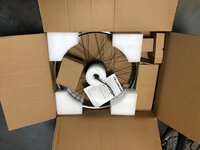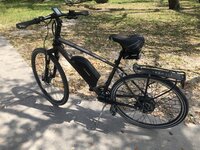What rear wheel, rear-hub, conversion kits should I be looking at for quality and performance?
Lots of eBike conversions (hub or mid-drive) emphasize low cost in order to just get started ebiking and try it out.
I've been using a Bosch mid-drive eBike, and now I want to try a rear-wheel conversion.
I need a 26"/559 rear wheel which I am guessing is a common option(?), but I'm only starting to search this out. A 650B/584/27.5 rear wheel would work fine too.
I'm good at building spoked wheels--is it better for me to get the hub and build it myself?
I prefer pedal assist / pedal-throttle, but maybe that's not as common for rear-hub conversions, or doesn't work as smoothly as for mid-drive?
I prefer not to have brake levers included in the kit, or will need to bypass and not use them if included. I think they're sometimes included because they have sensors in them that might be necessary for motor cut-off during braking.
I want to mount the battery on the frame (down tube probably using bottle mounts on top of downtube (and bottom mount too if possible)
Hoping for a 500 watt hour battery (or better) if I can find it in a usable size for mounting on bike frame.
thanks for any ideas or instruction for this newbie, -STW
Ok, so with those questions answered let me take a crack at your requirements from your original post. First off though I have no affiliation with Grin other than having just put over 1000 miles on one of their kits I installed last October.
Either a 26 or 27.5 rear is fine, but I think you'll find more road oriented tires and rims in the 27.5" size. This will create a "mullet" style bike (bigger in the back ... lol). You should be able to handle the wheel building just fine (there's a couple of good videos about building wheels with hub motors on Grin's website), but remember that you'll be working with a 36 hole rim (often harder to find these days, especially in the narrower sizes) and big 12-13 gauge spokes. A wheel like this becomes a strong and seriously stiff/noncompliant wheel, so tire choice and pressure will be important. If you don't want to bother, Grin builds some really nice wheels for not much money.
Pedal assist from Grin is IMHO about the best around. It's the way the Cycle Analyst handles the sensor and ramps up the power as you spin. The physical parts (sensor and it's mounting) are dead simple. The alternative is to delve into a torque monitoring BB (the torque sensor options). The upside is an even more natural feel to adding power, the downside is that these
specialized BBs can require drilling the BB mounting on the bike and/or require unique crank arms. If you're like me and picky about your crank arm length and such you may be better off staying away from the torque sensor and using only the PAS as this will give you more options in your choice of crankset and crankarms.
No problem not having brake sensors. Some folks prefer them, some don't (I don't ride with them). I think they become more important from a safety point of view if you are running higher power (kw class and up) motors. With the Grin kits there's usually a small multifunction switch setup that has a nice simple red power on/off switch on top. So if you ever did experience a sticky throttle (didn't shut off) then just pressing the little red button beside your thumb removes any problems. The real "need" for brake cut out sensors is on mid drive bikes that may not have a shift sensor installed. This way the motor's power can be briefly cut off while you shift (unloading the gears). With a hub motor this isn't a concern at all since the human is the only one putting pressure on the gears.
Your battery choice will be a balance between what you want for distance vs. weight, and there are a lot of variables that will affect the choice. As mentioned already you'll find it helpful to go down the rabbit hole of running Grin's motor simulator and trying out various battery capacities and voltages against various motors. This will show you what kind of range you can expect. You likely won't want to be carrying a lot of excess battery capacity. Also as mentioned above the Grin controllers (BaseRunner or PhaseRunner) can run any of the popular voltages so you have lots of choices.
I would recommend a standard wind motor and a 52v battery. This will give you a higher top speed vs. the often seen fast wind motors combined with cheap 36v batteries. If you choose a downtube style battery with a nice road frame you'll want to have a mounting plate under the battery base. This will do two things, first it gives you more flexibility in the position of the battery with respect to where your water bottle mounting bolts are (so you can alter the position of the battery up and down the downtube a bit), and second it offers a flat base to attach the battery base to. This prevents rocking which can destroy the water bottle nuts in the frame when a big heavy battery starts torquing on them sideways. These mounting plates are just the same as (and in many cases are the original) the water bottle mount extension products. I know this will sound like a broken record but Grin makes (IMHO) the best version of these mounting plates, the BOB.
Now I haven't mentioned a particular motor. This is going to be quite a personal choice that will depend on a bunch of options but primarily just how much power you want. Given what I assume is pretty reasonable power output on your part I think you'd be fine with a motor in the 500w class but I'll leave that conversation to the smarter folks around here. As always there is the inevitable trade off, in this case it's weight vs. power. All things being equal a bigger geared hub motor obviously gives you more torque (the voltage and wind speed will with the wheel diameter determine top speed) and the additional weight from the mass of the motor assembly dissipates more heat so they would take longer to overheat, if at all. Many motors now come with a temperature sensor so if things are all wired up correctly you can monitor the temp of the motor. The idea is to prevent it from overheating on long climbs and such. Grin's Cycle Analyst does this and will automatically start to roll back the power if the motor starts to overheat. This has an interesting effect of allowing you to run a slightly smaller (and lighter) motor that performs well and won't destroy itself if you push it too hard.
OK, that's probably TMI in one post, but you did ask ... lol.

